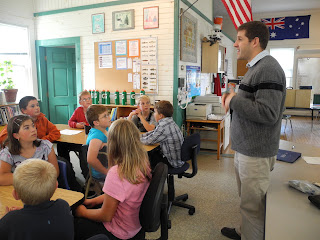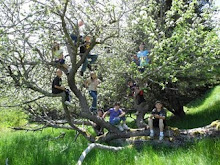 Perhaps I don't express often enough how lucky we are here at Frenchboro School. To think that we're on a remote island often conjures images of deprivation but this post is a perfect example of exclusive, amazing opportunities we get just because we're an outer island. Mr. Finn and I are such science junkies that whenever a scientist contacts us to work with the kids, we jump in with gusto. Last year at the STORMS conference in Orono, we were approached by Jochen Nuester, a scientist whose focus is on phytoplankton (more specifically the iron levels in phytoplankton...I know...who'd have thunk that was a specialty). He and his colleagues got a grant to take a research boat from South America to Australia. As part of the grant, they are encouraged to include an educational component. That's where our school comes in. The scientists will be working with us, teaching us about microbiology, and also communicating with us from their research vessel via Skype. So. Cool! Here's Jochen, giving us his background. I love that he's German and has the accent and the great hair. We don't get a lot of that out here in Frenchboro.
Perhaps I don't express often enough how lucky we are here at Frenchboro School. To think that we're on a remote island often conjures images of deprivation but this post is a perfect example of exclusive, amazing opportunities we get just because we're an outer island. Mr. Finn and I are such science junkies that whenever a scientist contacts us to work with the kids, we jump in with gusto. Last year at the STORMS conference in Orono, we were approached by Jochen Nuester, a scientist whose focus is on phytoplankton (more specifically the iron levels in phytoplankton...I know...who'd have thunk that was a specialty). He and his colleagues got a grant to take a research boat from South America to Australia. As part of the grant, they are encouraged to include an educational component. That's where our school comes in. The scientists will be working with us, teaching us about microbiology, and also communicating with us from their research vessel via Skype. So. Cool! Here's Jochen, giving us his background. I love that he's German and has the accent and the great hair. We don't get a lot of that out here in Frenchboro. Here's Ben Twining. He also studies phytoplankton and will be the one skyping us from the vessel as Jochen can't go because he has a little baby on the way. Ben described the process of gathering the plankton and where the boat will be located, as well as all the other researchers and their jobs.
Here's Ben Twining. He also studies phytoplankton and will be the one skyping us from the vessel as Jochen can't go because he has a little baby on the way. Ben described the process of gathering the plankton and where the boat will be located, as well as all the other researchers and their jobs. Then he showed us the phytoplankton net we'd be using and how it works. I had to laugh when I saw their net. Next to it, the one we got is like a little baby net.
Then he showed us the phytoplankton net we'd be using and how it works. I had to laugh when I saw their net. Next to it, the one we got is like a little baby net. Then it was time to get down to business! Of course the tide was low so it was a loooong drop off the ferry pier. Ben's first question...Anybody know how to tie a good knot? You're kidding, right? You do know you have a group of lobstering kids surrounding you?
Then it was time to get down to business! Of course the tide was low so it was a loooong drop off the ferry pier. Ben's first question...Anybody know how to tie a good knot? You're kidding, right? You do know you have a group of lobstering kids surrounding you? Brody was quick to help.
Brody was quick to help. Then down went the net.
Then down went the net. It was hard to get it into the water the second time as the wind kept turning it into a wind sock. There's definitely a technique to it because you're trying to get as much phytoplankton consolidated into the bottom as possible so you need to drag the net back and forth. It was like the circus came to town.
It was hard to get it into the water the second time as the wind kept turning it into a wind sock. There's definitely a technique to it because you're trying to get as much phytoplankton consolidated into the bottom as possible so you need to drag the net back and forth. It was like the circus came to town.

After many drags back and forth, they raised it up and Ben carefully removed the bottle at the bottom and sealed it up.
 Then it was back to the school to see what we got! I love this photo. I mean, really, how often do you get to take a stroll with a phytoplankton scientist? Probably asking him if he has any pets.
Then it was back to the school to see what we got! I love this photo. I mean, really, how often do you get to take a stroll with a phytoplankton scientist? Probably asking him if he has any pets.
I bet you thought it was only the scientists that arrived. Nope. Since we have the new Wednesday ferry, they drove out and brought all their equipment with them. Such awesomeness makes me all aflutter. Just look at those gadgets. My inner geek is doing cartwheels.
 There they are! Those are the barrel-shaped phytoplankton. One is a face-on view, and one is a side view, that's why they look like different shapes. It's like they were posing for us.
There they are! Those are the barrel-shaped phytoplankton. One is a face-on view, and one is a side view, that's why they look like different shapes. It's like they were posing for us. Then it was time to use OUR goodies and project the slide up on the big screen.
Then it was time to use OUR goodies and project the slide up on the big screen.  This is, apparently, a 'baby' crab. I'm cringing at all the seawater I've injested in my life as there was some weeeeird looking stuff in there.
This is, apparently, a 'baby' crab. I'm cringing at all the seawater I've injested in my life as there was some weeeeird looking stuff in there. This is a hugely magnified barrel phytoplankton. You can actually see internal structure. Uh-mazing.
This is a hugely magnified barrel phytoplankton. You can actually see internal structure. Uh-mazing. The kids got a chance to use the microscope that Jochen and Ben had brought with them. The double eyepiece took some getting used to.
The kids got a chance to use the microscope that Jochen and Ben had brought with them. The double eyepiece took some getting used to. Just look at the clarity. There were tons of zooplankton zooming in and out of the screen. Another scientist will come out to teach us about these little critters.
Just look at the clarity. There were tons of zooplankton zooming in and out of the screen. Another scientist will come out to teach us about these little critters.
 I believe this is a mollusk of some sort...
I believe this is a mollusk of some sort... Just look at how they chain together! They have a certain beauty to them.
Just look at how they chain together! They have a certain beauty to them.
This is a great magnification of a barrel phytoplankton from the side.

Beware. The eye of Sauron is watching you.

Wow. Holy tentacles, Batman.
 We got to map out where phytoplankton are mostly concentrated around the world. Then we were given some different aged solutions of phytoplankton to illustrate how the actual water changes color as the plankton multiply.
We got to map out where phytoplankton are mostly concentrated around the world. Then we were given some different aged solutions of phytoplankton to illustrate how the actual water changes color as the plankton multiply.
 Lastly we got to see how light affects the amount of phytoplankton using a special device that attaches to the computer and instantly charts the data.
Lastly we got to see how light affects the amount of phytoplankton using a special device that attaches to the computer and instantly charts the data. Thanks so much to our new friends from Bigelow Labs for taking the time to teach us. We can't wait for the next visit!
Thanks so much to our new friends from Bigelow Labs for taking the time to teach us. We can't wait for the next visit!

Thank you so much for posting the above article on ocean scientists, Jochen and Ben. How right you are that Frenchboro, isolated as it is, does indeed shine with an enormous margin of great happenings. I'd be all day commenting on the quantity of photos shown, but the word 'awesome' sums them up. Great class photo of the children with their new Bigelow Labs friends.
ReplyDelete